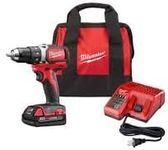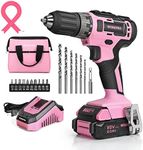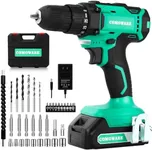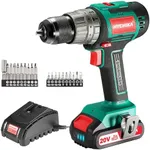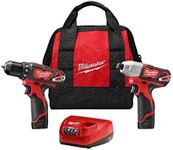Buying Guide for the Best Milwaukee Battery Drills
When choosing a Milwaukee battery drill, it's important to consider several key specifications to ensure you get the right tool for your needs. Battery drills are versatile and can be used for a variety of tasks, from simple home repairs to more demanding construction projects. Understanding the key specs will help you make an informed decision and select a drill that will serve you well for years to come.Battery VoltageBattery voltage determines the power of the drill. Higher voltage means more power, which is useful for heavy-duty tasks. Common voltages include 12V, 18V, and 20V. For light household tasks, a 12V drill is usually sufficient. For more demanding tasks like drilling into masonry or metal, an 18V or 20V drill would be more appropriate. Consider the types of projects you plan to undertake when choosing the voltage.
Battery Capacity (Ah)Battery capacity, measured in ampere-hours (Ah), indicates how long the battery will last on a single charge. Higher Ah means longer battery life. Typical capacities range from 1.5Ah to 5.0Ah or more. If you need the drill for extended use or larger projects, opt for a higher capacity battery. For occasional use or smaller tasks, a lower capacity battery will suffice.
Chuck SizeThe chuck size determines the maximum diameter of the drill bit that can be used. Common sizes are 3/8 inch and 1/2 inch. A 3/8 inch chuck is suitable for most household tasks and light-duty work. A 1/2 inch chuck is better for heavy-duty tasks and larger drill bits. Choose the chuck size based on the types of projects you plan to tackle.
Speed SettingsSpeed settings refer to the number of different speeds the drill can operate at. Most drills have two speed settings: low for driving screws and high for drilling. Some advanced models offer multiple speed settings for greater control. If you need versatility for different tasks, look for a drill with multiple speed settings. For basic use, two speed settings are usually sufficient.
TorqueTorque is the rotational force the drill can apply. Higher torque is necessary for driving screws into tough materials or drilling large holes. Drills often have adjustable torque settings to prevent overdriving screws. If you plan to work with a variety of materials, choose a drill with adjustable torque settings. For light-duty tasks, lower torque will be adequate.
WeightThe weight of the drill affects how comfortable it is to use, especially for extended periods. Lighter drills are easier to handle and reduce fatigue, but may have less power. Heavier drills are more powerful but can be tiring to use. Consider the balance between power and comfort based on how long you will be using the drill and the types of tasks you will be performing.
Additional FeaturesAdditional features such as LED lights, belt clips, and brushless motors can enhance the usability and performance of the drill. LED lights are useful for working in dark spaces, belt clips provide convenient storage, and brushless motors offer longer life and better efficiency. Think about which features will be most beneficial for your specific needs and choose a drill that includes those features.


